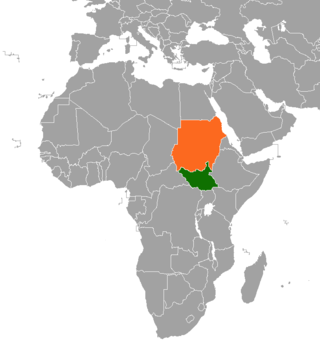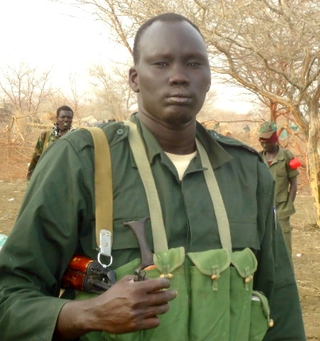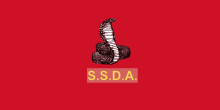
Jonglei State is a state of South Sudan with Bor as its centre of government and the biggest city. Jonglei state comprises nine counties: Bor, Akobo, Ayod, Uror, Duk, Nyirol, Pigi, Twic East, and Fangak. Jonglei State is the largest state by area before reorganisation, with an area of approximately 122,581 km2, as well as the most populous according to the 2008 census conducted in present-day South Sudan's second period of autonomy. The boundaries of the state were again changed as a result of a peace agreement signed on 22 February 2020.

The SPLA-Nasir was a splinter faction of the Sudan People's Liberation Army (SPLA), a rebel group that fought in the Second Sudanese Civil War. Originally created as an attempt by the Nuer tribe to replace SPLA leader John Garang in August 1991, it gradually became coopted by the government. The break away of Riek Machar from SPLM/A resulted in Nuer ethnic group massacring Garang's ethnic Dinka from Bor in the Bor massacre in 1991. This split resulted in the 1994 National Convention of New Sudan in Chukudum.

The South Sudan People's Defence Forces (SSPDF), formerly the Sudan People's Liberation Army (SPLA), is the army of the Republic of South Sudan. The SPLA was founded as a guerrilla movement against the government of Sudan in 1983 and was a key participant of the Second Sudanese Civil War, led by John Garang. After Garang's death in 2005, Salva Kiir was named the SPLA's new Commander-in-Chief. As of 2010, the SPLA was divided into divisions of 10,000–14,000 soldiers.

Sudanese nomadic conflicts are non-state conflicts between rival nomadic tribes taking place in the territory of Sudan and, since 2011, South Sudan. Conflict between nomadic tribes in Sudan is common, with fights breaking out over scarce resources, including grazing land, cattle and drinking water. Some of the tribes involved in these clashes have been the Messiria, Maalia, Rizeigat and Bani Hussein Arabic tribes inhabiting Darfur and West Kordofan, and the Dinka, Nuer and Murle African ethnic groups inhabiting South Sudan. Conflicts have been fueled by other major wars taking place in the same regions, in particular the Second Sudanese Civil War, the War in Darfur and the Sudanese conflict in South Kordofan and Blue Nile.

Gabriel Gatwech Chan, more commonly known by the nickname Tang-Ginye or Tanginye meaning "long pipe", was a Nuer and a commander in various primarily Nuer rebel militias in South Sudan. General Tanginye led a southern border militia allied to the Khartoum government during Sudan's civil war. Members of the Sudanese armed forces loyal to Tanginye in Malakal clashed with the Sudan People's Liberation Army (SPLA) in 2006, killing about 150 people, and in 2009 in breach of the peace deal. In April 2011, clashes between his militia and the SPLA in the state of Jonglei killed at least 57 according to government officials. Shortly thereafter, Tanginye surrendered to SPLA forces and was placed under house arrest in Juba awaiting charges against him. During the South Sudanese Civil War, he allied with the SPLA-IO and later Lam Akol's militia, a Juba linked rebel group called the National Democratic Movement (NDM) and became its chief of staff. In January 2017 he visited a NDM-allied group, the Tiger Faction New Forces, in the Hamra area in the northern Upper Nile. In course of this visit, the Tigers were attacked by SPLM-IO-affiliated fighters belonging to the militia of John Uliny, and Tanginye was killed alongside most of the Tigers.
Peter Gatdet Yak or Peter Gadet was a Sudan People's Liberation Army (SPLA) general who became the leader of the South Sudan Liberation Army (SSLA), a rebel movement in South Sudan.

South Sudan is home to around 60 indigenous ethnic groups and 80 linguistic partitions among a 2021 population of around 11 million. Historically, most ethnic groups were lacking in formal Western political institutions, with land held by the community and elders acting as problem solvers and adjudicators. Today, most ethnic groups still embrace a cattle culture in which livestock is the main measure of wealth and used for bride wealth.
The history of South Sudan comprises the history of the territory of present-day South Sudan and the peoples inhabiting the region.
Paulino Matip Nhial, or Matiep Nhial, was a military leader and politician in South Sudan.
Yohannes Yual Both was a leader of the South Sudan Defense Forces whose mobile forces gave the Sudan People's Liberation Army considerable difficulty during the Second Sudanese Civil War (1983–2005).
Ethnic violence in South Sudan has a long history among South Sudan's varied ethnic groups. South Sudan has 64 tribes with the largest being the Dinkas, who constitute about 35% of the population and predominate in government. The second largest are the Nuers. Conflict is often aggravated among nomadic groups over the issue of cattle and grazing land and is part of the wider Sudanese nomadic conflicts.

The Nuer White Army, sometimes decapitalised as the "white army", is a semi-official name for a militant organisation formed by the Nuer people of central and eastern Greater Upper Nile in modern-day South Sudan as early as 1991. According to the Small Arms Survey, it arose from the 1991 schism within the Sudan People's Liberation Movement/Army (SPLM/A) for the dual purpose of defending Nuer cattle herds from neighbouring groups and fighting in the Second Sudanese Civil War between the SPLM/A and the Sudanese government.

David Yau Yau was a Governor of Boma State and the Chief Administrator of the Greater Pibor Administrative Area of South Sudan. He was previously the leader of a Murle insurrection against the South Sudanese government.

The South Sudanese Civil War was a multi-sided civil war in South Sudan between forces of the government and opposition forces. In December 2013, President Kiir accused his former deputy Riek Machar and 10 others of attempting a coup d'état. Machar denied trying to start a coup and fled to lead the SPLM – in opposition (SPLM-IO). Fighting broke out between the Sudan People's Liberation Movement (SPLM) and SPLM-IO, igniting the civil war. Ugandan troops were deployed to fight alongside the South Sudanese government. The United Nations has peacekeepers in the country as part of the United Nations Mission in South Sudan (UNMISS).
John Uliny, also known as Johnson Olony, Johnson Olonyi, and John Olony, is a South Sudanese militia leader. He is a member of the Shilluk ethnic group. He has at various points in time been allied with the South Sudan Democratic Movement, the Sudan People's Liberation Movement-in-Opposition and has led his own Agwelek Forces. He fought the South-Sudanese governement in Upper Nile State between 2016 and 2018.

The Greater Pibor Administrative Area is an administrative area in South Sudan.

Boma State was a state in South Sudan that existed between 2 October 2015 and 22 February 2020. It was located in the Greater Upper Nile region and was formerly part of the state of Jonglei. The state bordered Akobo State, Imatong State, Jonglei State, Kapoeta State, Bieh State, Terekeka State and the country of Ethiopia to the east.
The Tiger Faction New Forces was a Shilluk militia that took part in the South Sudanese Civil War with the aim of reversing the division of South Sudan into 28 states in order to restore the territory of the Shilluk Kingdom per its 1956 borders. Led by Yoanis Okiech, the TFNF originally split from the Sudan People's Liberation Army (SPLA) in late October 2015 and subsequently started an insurgency against the SPLM government. In course of 2016, however, it also came into conflict with SPLM-IO rebels, leading to inter-rebel fighting which resulted in Okiech's death and the group's destruction in January 2017.

Elections were held in Jonglei State on 10–15 April 2010 as part of the 2010 Sudanese general election, with voting for President of Sudan, National Assembly of Sudan, President of Southern Sudan, Southern Sudan Legislative Assembly, Governor of Jonglei State and the Jonglei State Legislative Assembly. The elections were the first in Sudan for over two decades, held in the aftermath of the 2005 Comprehensive Peace Agreement between the Sudan People's Liberation Movement (SPLM) and the Government of Sudan of Omar al-Bashir. The election was carried out in precarious security conditions, with ethnic conflicts prevalent in the state. The elections were won by the SPLM, with the exception of a handful of seats. Disputes over the election results led to the outbreak of two armed insurgencies.

George Athor's rebellion was an uprising in the Southern Sudan Autonomous Region which lasted from April 2010 to December 2011. Organized by South Sudanese military commander and politician George Athor, the conflict mainly took place in the states of Upper Nile and Jonglei as well as some border areas.














